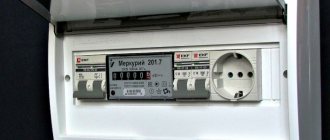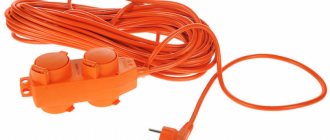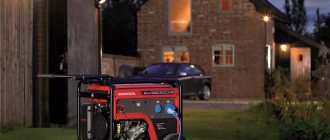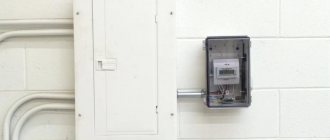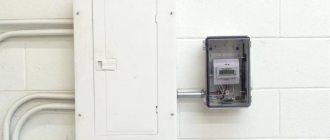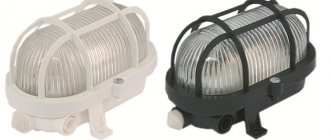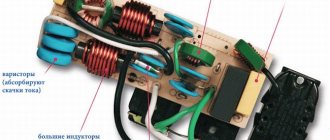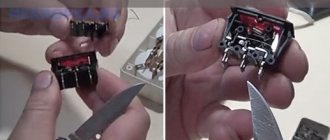An electrical extension cord allows you to connect devices located far from outlets to the network. An inexperienced user, when choosing, always focuses solely on the length of the cable, sometimes on the number of plug sockets. This approach is only correct if connections are required by really low-power electrical appliances, such as a table lamp or an ordinary kitchen mixer. In all other situations, the choice should be approached wisely.
How to choose an electrical extension cord
Manufacturers of most electrical appliances often advise in their instructions not to connect them via an extension cord. And this is correct, because some of the power is lost on the additional length of the wire. And if the product is of poor quality, this can even lead to a short circuit or fire of the cord as a result of its overheating. But if you cannot do without additional meters, your choice should be based on the characteristics below.
Degree of protection
For standard extension cords there are 2 options for the degree of protection:
- IP20 – designed for indoor use without a lot of dust. Equipped with open types of sockets.
- IP44 – Allowed to work in very dusty rooms or in open spaces in the rain. These extension cords have a waterproof casing, and all sockets have protective covers.
Cable type
On extension cords designed to work with a household network, two types of wires are installed:
- KG (flexible cable) – designed for professional work. Easily withstands temperatures from -40° to +40°. This wire bends without damage and is resistant to abrasion. It has 2 versions: T – ambient temperature up to +50°, HL – up to -60°.
- PVA (connecting wire with PVC sheath) – designed to operate at temperatures above +1°. This option is almost a third cheaper than the previous one, but it is not resistant to abrasion and eventually cracks at the bends. At low temperatures, the insulation breaks down when bent. Extension cords with this cable are used primarily indoors.
Maximum permissible load (power) and cross-section
The indicator determines the total power of connected devices. The higher the maximum permissible load, the larger the cross-section of the wires.
There are 3 types:
- low-power - up to 1 kW, cross-section 0.5-0.75 mm;
- average power – up to 2.2 kW, cross-section 1 mm;
- increased power - 3.5 kW, cross-section 1.5-2.5 mm.
The permissible load is indicated on the housing. When connecting electrical appliances whose total power exceeds this parameter, the extension cord may fail: the wiring heats up and melts, and the wire connections burn out. This often leads to fires and smoke, so special attention should be paid to the load. Since a long wire creates serious additional resistance, if its length is more than 50 m, a cross-section of 2.5 mm must be required.
Length of cable
A parameter that is selected depending on the situation. In the home and office, extension cords are often used for a maximum of 5 meters, while work on construction sites often requires 20 or more meters of cable length. It is important to remember here that the large length creates inconvenience in using the extension cord, so it is better to pay attention to models with a reel for winding.
When working with a long wire that is used to power a powerful tool, it must be completely unwound from the spool. The fact is that induction leads to overheating of the cable assembled in rings. Some models have built-in overload protection in the form of fuses. It is recommended to choose these extension cords.
Grounding
An additional cable core for grounding connection (if there is a corresponding contact in the socket) performs a protective function. It not only prevents electric shock when operating a faulty electrical appliance, but also reduces the level of interference on equipment connected both within the same network and simply located nearby. Such extension cords should be purchased if they are intended to be used with constantly switched on devices, such as televisions or refrigerators.
Number of sockets
This indicator depends only on the design of a particular model. Obviously, the number of connected devices depends on the number of sockets. As a rule, most extension cords have from 1 to 4 sockets, but there are options with more of them.
Options
If necessary, you can choose an extension cord with additions, such as USB connectors for charging mobile phones, a power button that allows you to turn off the power to devices without having to remove the plug from the socket. The presence of protective curtains will be useful if children have access to the extension cord, and the network indicator will always indicate whether electricity is flowing through the wires.
Cable type
The type of wire is selected depending on the conditions in which the extension cord will operate. Among the most common options:
- PVS – the wire has a sheath of plasticized PVC, copper cores, a round cross-section, and is inexpensive, which affects the final price of the extension cord. The material is afraid of negative temperatures, becomes tanned in the cold, and is also susceptible to abrasion. For domestic conditions, when the extension cord is not particularly tugged or frozen, this type of cable is perfect. Another disadvantage is the sufficient massiveness, but it becomes critical when the core cross-section is more than 2.5 mm2;
- SHVVP It is used much less frequently and is distinguished by a flat cut. Due to the thinner insulation, the cable takes up less space. It is suitable for domestic conditions, but under heavy loads, for example, at a construction site, it may not withstand and become unusable;
- KG (flexible cable) suitable for harsh conditions. The core insulation and cable sheath are made of rubber. This cable can withstand frost and heat and is resistant to mechanical stress, which is why it is the best option for difficult construction conditions. However, such a wire should not be left in direct sunlight for a long time.
Best Electrical Extension Cord on Reel
The extension cord on a reel ZUBR 55075-50 is perfect for working on construction sites and extended summer cottages. For the manufacture of power busbars, high-quality brass is used, the PVA wire has a cast plug (shock-resistant, rubberized) and double insulation, where each core has its own fireproof sheath. To connect consumers, one socket of a collapsible design is installed, which makes it easy to replace in case of breakdown.
The terminals are securely attached to the cable, which prevents sparking and heating due to weak contact. To securely fix the cable on the reel, there are special clamps that also prevent it from unwinding spontaneously. The frame of the structure is made of metal and equipped with a convenient handle for carrying.
Characteristics
- permissible load – 2.2 kW;
- length – 50 m;
- current – 10 A;
- wire characteristics: type – PVA, number of cores – 2, cross-section – 1 mm2;
- number of sockets – 1.
pros
- double insulated cord;
- wire length;
- the presence of a collar on the coil that prevents abrasion of the wire;
- the presence of clamps for fixing the wire;
- stable reel frame.
Minuses
- only one socket;
- no grounding.
Number of sockets and plug type
The number of sockets varies from 1 to 4, or even up to 5-6. Such a large number of sockets are made not so that you can use 4-6 devices at once, but so that you can insert a plug and not remove it for a long time. There are still empty slots. Thus, both the extension cord and the cord of the electrical appliance will last longer.
Don't chase too many outlets - take the extension cord that suits your needs. If you are going to connect only one device, then there is no point in taking an extension cord for 4 outlets.
Pay attention to how the plug-in contacts of the sockets are located. The most convenient location is diagonally. In other cases, it may be problematic to connect two devices to adjacent sockets.
Have you inspected the outlet block? It's time to look at the extension plug. Give preference to cast forks , which are more reliable and safer. In addition, such plugs are more difficult to produce, so in this case it will be more difficult to run into a makeshift extension cord.
Molded fork
Collapsible fork
Best Household Electrical Extension Cord
This is a compact household extension cord Power Cube PC-Y-2-05-3 with 5 sockets (3 on one side, 2 on the reverse), the body of which is made of fire-resistant polypropylene. The wire cores are made of pure copper, which reduces the intensity of radiated interference. The double-sided arrangement of sockets is an excellent solution for saving space, but this model cannot be hung on the wall.
Power Cube PC-Y-2-05-3 has a degree of protection IP20. In other words, its use in a humid environment is prohibited. The case has sufficient resistance to mechanical stress, which ensures long-term operation.
Characteristics
- load – 2.2 kW;
- length – 3 m;
- current – 10 A;
- wire parameters: type - PVA, number of cores - 2, cross-section of each core - 0.75 mm2;
- number of sockets – 5.
pros
- compactness due to the location of sockets on both sides;
- minimum radiated interference due to pure copper in the cable;
- fire-resistant housing material.
Minuses
- no grounding;
- impossible to hang on the wall.
Network filters and pilots
A surge protector is an extension cord in which a unit is installed in the socket block, which can be called a filter. The filter can be one varistor (the blue part with two terminals, not to be confused with a capacitor) or even a whole block with chokes, varistors, suppressors and arresters.
Almost every switching power supply contains such a filter, so there is no need to buy a surge protector for city residents. It can only be useful for villagers or summer residents.
In the photo, only the upper pilot-s and lower vektor solo have a good surge protector installed. On other models there is only a varistor.
Due to the popularity of the domestic company Pilot, this name has already become a household name for all network filters.
Best Electrical Extension Cord with Grounding
Power extension cord for 1 socket LUX YC1-E-10, 10 meters long. Suitable for work on construction sites and garden plots. Designed for connecting low-power electrical appliances located away from the network. It is based on a three-core PVA wire with a cross-section of each core of 0.75 mm.
The bright orange color of the wire is clearly visible from afar. The device is equipped with grounding, which increases the safety of operation of electrical appliances, and a non-removable plug, which is equipped with an anti-burglary element.
Characteristics
- permissible load – 2.2 kW;
- length – 10 m;
- current – 10 A;
- wire parameters: type – PVA, number of cores – 3, cross-section – 0.75 mm2;
- number of sockets – 1.
pros
- affordable price;
- presence of grounding;
- noticeable cable color;
- rubberized coating.
Minuses
- the need to completely unwind the wire before work;
- There is insufficient power for the power cable.
Table of comparative characteristics of power extension cords
| Model name | Form | Cable length, m | power, kWt | IP | Grounding | Number of sockets | price, rub. |
| Cord | 50 | 2,2 | 44 | No | 1 | From 2616 |
| Cord | 10 | 3,5 | 44 | Eat | 1 | From 721 |
| Cord | 10 | 3,5 | 44 | Eat | 3 | From 1100 |
| Cord | 30 | 3,5 | 44 | No | 5 | From 1249 |
| Cable on frame | 30 | 1,3 | 20 | No | 1 | From 659 |
| Cable on frame | 20 | 1,3 | 20 | No | 1 | From 513 |
| Cable on frame | 30 | 2,2 | 20 | No | 1 | From 1050 |
| Reel | 50 | 2,2 | 44 | No | 1 | From 2297 |
| Reel | 10 | 2,2 | 20 | Eat | 4 | From 913 |
| Reel | 50 | 2,2 | Unknown | No | 4 | From 1699 |
| Glanzen 4 sockets 50m EB-50-008 16A IP20 b/c | Reel | 50 | 3,5 | 20 | No | 4 | From 2914 |
| Reel (metal) | 30 | 3,5 | 20 | Eat | 4 | From 2090 |
| Reel | 50 | 3,5 | 44 | Eat | 4 | From 2787 |
Best Electrical Extension Cord with Switch
Powerful electrical extension cord Brennenstuhl 1391000016 for 6 sockets (at an angle of 45°) with surge protector function. The body of the model is made of aluminum, which increases its strength; there are grooves around the perimeter for winding excess cable length. An illuminated switch is installed to indicate the presence of current in the network. In addition, there is an eyelet on the body, which makes it possible to place it on the wall.
The high-quality surge protector built into the Brennenstuhl 1391000016 reliably protects connected electrical appliances from overcurrent, excessive load and short circuit. Each outlet has safety shutters for added safety.
Characteristics
- permissible load – 3.5 kW;
- length – 3 m.
- current – 10 A;
- wire parameters: type – PVC, number of cores – 3;
- number of sockets – 6.
pros
- high load power;
- 6 sockets;
- built-in surge protector;
- durable aluminum housing;
- presence of a switch.
The downside is the long body length.
Internals of extension cords
One of the most common types is the so-called computer extension cord or surge protector. It has a built-in switch in the case that can be used to turn off the power to all outlets.
It is usually designed for a current of 10A (power 2.2 kW). Each socket in them has a grounding contact. Which is extremely necessary for apartments with three-wire wiring (phase-zero-ground).
The supply wire on high-quality models must be marked. The brand and core cross-section are stamped on it.
Do not buy carriers where the cross-section of the wires is less than 0.75 mm2 or where there are no identification marks on the wires at all.
However, you should not particularly trust the thickness of the cable itself. It is quite possible that the insulation in it will be quite thick, but the veins will be very thin.
Such a wire will definitely heat up, even with minimal load.
The most important thing in such models is that there is not just a switch inside, but an “automatic machine” that will automatically operate when the load is exceeded.
This extension cord is used to power computers, LCD and LED TVs, printers and other household appliances.
How does it protect equipment from voltage surges? In order to understand this, you need to look inside the case.
To do this, unscrew the screws on the back side and remove the cover. The contact pads of the carrying sockets must be made of brass plates.
Most of them are 0.3mm thick. Higher quality models for high currents have a thickness of up to 0.6 mm.
In cheap Chinese counterfeits you can find not brass, but just iron plates coated with brass. You can check this with an ordinary magnet. Non-ferrous metal will not be magnetic, but iron will easily.
In addition to worse conductivity, the iron contacts after the first use of a wide Euro plug will expand and will not return to their reverse state. Brass has significant elasticity.
By the way, many “Soviet” plugs will not fit into such connectors due to the presence of side grounding pins.
The most important element that protects all connected equipment is a varistor. Phase and zero approach it from both sides. With a short-term voltage surge (about 300V), its resistance drops sharply, but the current flowing through it increases.
Due to this, the voltage on the varistor itself is stabilized. If the surge is not short-term, but the overvoltage occurs constantly, then it simply closes the circuit and an artificial short circuit is created inside the case.
That is, if the voltage in the sockets jumps and remains within 300V, the internal resistance of the varistor sharply decreases (down to zero), and it trips, creating a short circuit.
And it is from this short circuit that the circuit breaker turns off, protecting all connected devices.
Higher quality products are equipped with several varistors, plus capacitors and inductors.
In inexpensive ones, all protection ends with a varistor and a circuit breaker or push-button fuse.
It is recommended to use such a carrying extension cord specifically for household appliances, and not for power tools - grinder, drill, hair dryer, etc. By including powerful devices in it, you reduce the service life of the extension cord by several times.
The plates themselves are not spring-loaded, although they are brass. And at relatively high currents they burn out quickly.
Best Electrical Extension Cord with USB
The extension cord Navigator npe-usb-05-180-esc-3×1.0 is intended for household use. It has 5 plug sockets with grounding for connecting electrical appliances, as well as 2 USB connectors, each of which has 2.1 A and 5 V for charging various equipment, such as mobile phones. The model is equipped with built-in overload protection, as well as a shock-resistant case made of flame-retardant plastic. Navigator npe-usb-05-180-esc-3×1.0 has a modern design.
There is a switch on the case for convenient disconnection from the power supply without the need to remove the plug from the power outlet. Great for use in the office or home.
Characteristics
- permissible load – 3.5 kW;
- length – 1.8 m;
- maximum current – 16 A;
- wire parameters: number of cores – 3, cross-section – 1 mm2;
- number of sockets – 5.
pros
- 5 plug sockets;
- 2 USB ports;
- presence of a switch.
Grounding
Grounding is a useful option that will reduce the risk of electric shock when operating a faulty electrical appliance, and will also reduce the level of interference in equipment connected to the same network or located nearby. The grounding conductor is especially important when connecting to the extension cord of a washing machine and refrigerator. True, grounding will be relevant only when the apartment is connected to the ground loop.
Best electrical extension cord on frame
The powerful power extension cord PowerCube PC-LG5-R-30 with a cable length of 30 m allows you to easily solve the problem of connecting remote electrical appliances. There are 5 sockets on the case, each of which is grounded and connected to a common switch with a current indicator light. The model is assembled on the basis of an organizer in the form of a frame, which allows you to carefully wind up and store the cable, and also prevents it from tangling.
PowerCube PC-LG5-R-30 is produced in classic black color, ideal for use on construction sites and personal plots. There is a simple handle on the side of the case for easy carrying.
Characteristics
- permissible load – 3.5 kW;
- length – 30 m;
- maximum current – 16 A;
- wire parameters: number of cores – 3, cross-section – 1 mm2;
- number of sockets – 5.
pros
- long cable;
- high power;
- low cost;
- presence of an organizer for laying wires.
Mechanical protection
A high-quality model must have protection against pulling and bending of the wire.
This applies equally to both the connector with the plug and the place where the conductors enter the extension cord housing.
Never operate a carrier with twisted wires. Firstly, this will sooner or later lead to damage to the cores, and secondly, such a cable will simply heat up.
Please note that extension cords can only withstand their rated load when the cable is completely unwound. On the case, sometimes special symbols are applied, with the maximum current when the wire is wound and unwound.
Range.
| Name | Number of sockets | Length | Amount in a package | vendor code | |
| Extension cord U02 without switch | 2 | 2 | 60 | WYP10-06-02-02-Z | |
| Extension cord U02 without switch | 2 | 3 | 60 | WYP10-06-02-03-Z | |
| Extension cord U02 without switch | 2 | 5 | 40 | WYP10-06-02-05-Z | |
| Extension cord U03 without switch | 3 | 2 | 60 | WYP10-06-03-02-Z | |
| Extension cord U03 without switch | 3 | 3 | 60 | WYP10-16-03-03-Z | |
| Extension cord U03 without switch | 3 | 5 | 40 | WYP10-16-03-05-Z | |
| Extension cord U04 without switch | 4 | 2 | 60 | WYP10-06-04-02-Z | |
| Extension cord U04 without switch | 4 | 3 | 40 | WYP10-16-04-03-Z | |
| Extension cord U04 without switch | 4 | 5 | 30 | WYP10-16-04-05-Z | |
| Extension cord U05 without switch | 5 | 3 | 40 | WYP10-16-05-03-Z | |
| Extension cord U05 without switch | 5 | 5 | 30 | WYP10-16-05-05-Z | |
| Extension cord U06 without switch | 6 | 3 | 40 | WYP10-16-06-03-Z | |
| Extension cord U06 without switch | 6 | 5 | 30 | WYP10-16-06-05-Z | |
| Extension cord U2 without switch | 2 | 2 | 60 | WYP10-06-02-02 | |
| Extension cord U2 without switch | 2 | 3 | 60 | WYP10-06-02-03 | |
| Extension cord U2 without switch | 2 | 5 | 40 | WYP10-06-02-05 | |
| Extension cord U3 without switch | 3 | 2 | 60 | WYP10-06-03-02 | |
| Extension cord U3 without switch | 3 | 3 | 60 | WYP10-16-03-03 | |
| Extension cord U3 without switch | 3 | 5 | 40 | WYP10-16-03-05 | |
| Extension cord U4 without switch | 4 | 2 | 60 | WYP10-06-04-02 | |
| Extension cord U4 without switch | 4 | 3 | 40 | WYP10-16-04-03 | |
| Extension cord U4 without switch | 4 | 5 | 30 | WYP10-16-04-05 | |
| Extension cord U5 without switch | 5 | 3 | 40 | WYP10-16-05-03 | |
| Extension cord U5 without switch | 5 | 5 | 30 | WYP10-16-05-05 | |
| Extension cord U6 without switch | 6 | 3 | 40 | WYP10-16-06-03 | |
| Extension cord U6 without switch | 6 | 5 | 30 | WYP10-16-06-05 | |
| Extension cord U02K with switch | 2 | 2 | 60 | WYP10-06-02-02-ZК | |
| Extension cord U02K with switch | 2 | 3 | 60 | WYP10-06-02-03-ZК | |
| Extension cord U02K with switch | 2 | 5 | 40 | WYP10-06-02-05-ZК | |
| Extension cord U03K with switch | 3 | 2 | 60 | WYP10-06-03-02-ZК | |
| Extension cord U03K with switch | 3 | 3 | 60 | WYP10-16-03-03-ZК | |
| Extension cord U03K with switch | 3 | 5 | 40 | WYP10-16-03-05-ZК | |
| Extension cord U04K with switch | 4 | 2 | 60 | WYP10-06-04-02-ZК | |
| Extension cord U04K with switch | 4 | 3 | 40 | WYP10-16-04-03-ZК | |
| Extension cord U04K with switch | 4 | 5 | 30 | WYP10-16-04-05-ZК | |
| Extension cord U05K with switch | 5 | 3 | 40 | WYP10-16-05-03-ZК | |
| Extension cord U05K with switch | 5 | 5 | 30 | WYP10-16-05-05-ZК | |
| Extension cord U06K with switch | 6 | 3 | 40 | WYP10-16-06-03-ZК | |
| Extension cord U06K with switch | 6 | 5 | 30 | WYP10-16-06-05-ZК | |
| Extension cord U3K with switch | 3 | 3 | 60 | WYP10-16-03-03-K | |
| Extension cord U3K with switch | 3 | 5 | 40 | WYP10-16-03-05-K | |
| Extension cord U4K with switch | 4 | 3 | 40 | WYP10-16-04-03-K | |
| Extension cord U4K with switch | 4 | 5 | 30 | WYP10-16-04-05-K | |
| Extension cord U5K with switch | 5 | 3 | 40 | WYP10-16-05-03-K | |
| Extension cord U5K with switch | 5 | 5 | 30 | WYP10-16-05-05-K | |
| Extension cord U6K with switch | 6 | 3 | 40 | WYP10-16-06-03-K | |
| Extension cord U6K with switch | 6 | 5 | 30 | WYP10-16-06-05-K | |
| Extension cord U-S03K with switch | 3 | 3 | 40 | WYP30-16-03-03-ZК | |
| Extension cord U-S03K with switch | 3 | 5 | 40 | WYP30-16-03-05-ZК |
How to assemble an extension cord yourself
An electrical extension cord is designed to supply power to electrical appliances that are remote from outlets. There are a huge number of carriers on sale, which differ in the cross-section and length of the cable used. But by assembling the extension cord yourself, you can get a reliable, high-quality and safe device. In this case, the required carrying length is selected, which will avoid the problem of insufficient or excess wires.
To make an extension cord with your own hands, you will need to prepare:
- cable;
- socket block;
- collapsible fork.
You will also need to have a minimum set of tools. It takes about twenty minutes to assemble the carrier. The following is a step-by-step instruction for the process of making an extension cord:
- At the first stage, the upper protective sheath of the cable is removed, approximately five centimeters.
- Subsequently, one centimeter of the insulating layer is removed from the ends of each individual conductor.
- The prepared wires are connected on one side to the terminals of the extension cord socket, and on the other to the plug. In this case, it is necessary to ensure good contact by tightly tightening the terminals, as well as fixing the wire in insulation with a special clamp inside the plug. Otherwise, the contact part heats up and breaks down over time.
- Check the carrier for breaks using a multimeter.
- Reinstall the protective covers of the plug and extension cord, securing them with fasteners.
When making a carrier longer than twenty meters, you should use a reel for winding the cable line.
Switch
Some extension cord models are equipped with a switch. This can be convenient when the extension cord includes devices that do not have their own switch, such as chargers for gadgets. Switch buttons on extension cords can be wide or narrow.
Wide switch buttons completely disconnect the extension cord from the network: they disconnect the phase and neutral wires. When the extension cord is turned off, narrow buttons open only one contact, thereby interrupting the current supply. In this case, voltage may remain on one of the contacts of the socket if the neutral wire is open (which wire will be opened by pressing the button depends on how the extension cord plug is plugged into the socket). In this case, although the load will be disconnected, you may receive an electric shock if you touch one of the contacts (for example, when replacing a light bulb in a table lamp).
Many switches have a built-in indicator that lights up when there is mains voltage present at the outlets.
Extension cords are available that have a separate switch for each outlet. Extension cords with individual switches will help reduce energy consumption by devices that are not currently in use without disconnecting them from the extension cord. This type is especially relevant in the kitchen, workshop, country house, office - anywhere where several electrical appliances are expected to be used, but not always at the same time.
Requirements for extension cords and carriers - Fire safety
An electrical extension cord is a device that serves to supply power to electrical consumers when their cord is not long enough to reach a fixed outlet. Most often, the extension cord design includes several sockets, so it allows you to connect several consumers at the same time.
The nuances of choosing conductor cores for carrying
To make your own carrying case, it is recommended to use a three-core cable with soft insulation. One core is intended to perform protective grounding. As a rule, it is colored yellow-green. Preference should be given to stranded copper wires in double insulation, preferably rubber. This is due to operational factors: friction, bending, temperature effects, mechanical load on the insulating layer, etc.
Types of extension cable
Now we will consider the most practical options for current-carrying conductors for completing the extension cord, as well as the procedure for selecting the required cross-section.
Brand KG
Frost-resistant type of cable, which is recommended for use outdoors, but without prolonged direct exposure to ultraviolet rays. They contribute to the destruction of the rubber protective sheath of current-carrying conductors. This type of cable line is excellent for carrying, which is often subject to bending and compression. Such conditions are typical for construction projects.
Carrier made of KG 3x4 wire with rubber insulation
The KG brand can be used at temperatures from - 40 to + 50 degrees Celsius. The estimated number of bending cycles is at least 30 thousand with a four-year service life.
Brand KGN
Can be used under conditions of exposure to aggressive factors. These include various chemicals, oils and sparks. Main technical characteristics:
- operating temperature range - from – 30 to + 50;
- rubber protective layer;
- maximum number of bending cycles - at least 30 thousand;
- service life - 2.5 years.
Design of oil-resistant cable KGN
Brand PVS
The insulating layer of conductive cores made of PVC plastic does not collapse under the influence of sunlight, but loses its plasticity at low temperatures. In this regard, it is recommended to use PVA cable for carriers used at positive temperatures. According to factory indicators, the service life of the PVA brand is more than six years at temperatures ranging from – 25 to + 40 degrees Celsius. The wire is designed to withstand at least thirty thousand bending cycles.
Connecting wire PVA 3x2.5 white
Brand PRS
This extension cord can be used both outdoors and indoors. Has the following indicators:
- operating temperature range - from – 40 to + 40;
- number of bending cycles - 30 thousand;
- insulation - rubber;
- service life - more than six years.
Connecting cable with rubber insulation PRS
Selecting and checking cable cross-section
The most commonly used wire sizes for carriers from 5 to 10 meters in length are:
- 0.75-1 mm2 - for voltage 220 Volts;
- 1.5-2.5 mm2 - at a voltage of 380 Volts.
To independently select the extension cord cross-section, you will need to take into account the length of the cable line and the planned load. These indicators directly affect the amount of power loss in the wire. Their compensation is ensured by using a larger cross-section of the conductor.
The use of extension cords with an incorrectly selected cross-section can lead to heating of the conductors, which is often accompanied by a short circuit.
Table of power wire cross-section depending on power
To determine the required cable cross-section for the extension cord, you will need to perform the following calculations:
- Initially, you will need to determine the planned power (P) of the connected consumers in order to calculate the current load on the wire. To do this, use the following formula: I = P/U, where U is the mains voltage.
- Based on the obtained value, we select the appropriate cross-section of the current-carrying conductors, according to Table 1.3.4 of the PUE.
- In the future, you need to check the selected cross-section to ensure it matches the cable length used. To do this, calculate the total resistance of the extension cable line using the formula: R = pxL/S, where:
- p—resistivity (0.0175 for copper);
- L is the length of the cable carrying line;
- S is the section selected in the second paragraph.
- The voltage loss value is calculated: U = IxR.
Now it remains to determine the percentage of losses. To do this, you need to divide the amount of voltage loss by the value of the supply voltage and multiply by one hundred. If a value of less than five percent is obtained, the selected cross-section and length of the extension cord meet the established standards. If there is an excess of 5%, then you will need to choose a cable with a larger cross-section. Then repeat the calculations from the third and fourth points.

